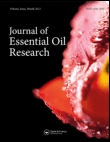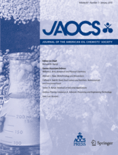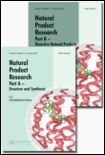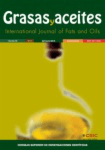
JOURNAL OF ESSENTIAL OIL RESEARCH
Scope & Guideline
Unlocking the Secrets of Essential Oils
Introduction
Aims and Scopes
- Chemical Composition Analysis:
The journal publishes studies that investigate the detailed chemical profiles of essential oils derived from various plant species, including their volatile compounds and enantiomeric distributions. - Biological Activity Evaluation:
Research articles often focus on the antimicrobial, antioxidant, anti-inflammatory, and insecticidal activities of essential oils, exploring their potential therapeutic applications. - Extraction and Isolation Techniques:
The journal includes methodologies related to the extraction and isolation of essential oils, comparing traditional and innovative techniques to optimize yield and quality. - Phytochemical Studies:
Papers frequently delve into the phytochemistry of essential oils, discussing their potential health benefits and applications in pharmacology and agrochemicals. - Environmental and Agronomic Factors:
Research examining the influence of environmental conditions and agricultural practices on the yield and composition of essential oils is a consistent focus, highlighting the significance of cultivation practices.
Trending and Emerging
- Nanoemulsion and Delivery Systems:
Recent studies have increasingly explored the use of nanoemulsions for enhancing the delivery and efficacy of essential oils, particularly in food applications and antimicrobial formulations. - In Vitro and In Silico Analyses:
There is a growing trend in utilizing in vitro and in silico methods to assess the biological activities of essential oils, providing a modern approach to understanding their mechanisms of action. - Sustainability and Eco-Friendly Practices:
Research focusing on sustainable extraction methods and the environmental impact of essential oil production is gaining traction, aligning with global sustainability efforts. - Health Applications and Therapeutics:
An increase in studies evaluating the therapeutic potentials of essential oils in treating various health issues, including their role in managing diseases like diabetes and infections, is evident. - Interdisciplinary Applications:
The integration of essential oils in interdisciplinary fields, such as food preservation, pest control, and biomedicine, is becoming more prominent, showcasing their versatility.
Declining or Waning
- Traditional Uses and Ethnobotanical Studies:
There has been a noticeable decrease in papers addressing the traditional uses and ethnobotanical aspects of essential oils, as the focus shifts more towards scientific validation and novel applications. - Non-Biological Applications:
Research related to the use of essential oils in non-biological applications, such as cosmetics or perfumery, has seen a reduction, possibly due to a growing emphasis on health-related and agricultural applications. - Chemical Synthesis of Essential Oils:
Studies focusing on the synthetic production of essential oil compounds have become less frequent, reflecting a shift towards natural extraction and sustainability.
Similar Journals

Chemical Methodologies
Empowering Researchers with Open Access to ChemistryWelcome to Chemical Methodologies, a premier journal published by SAMI PUBLISHING CO-SPC, dedicated to advancing the field of chemistry through innovative research and methodologies. With an ISSN of 2645-7776 and an E-ISSN of 2588-4344, this journal provides a vital platform for researchers and scholars to share their findings in areas encompassing physical, theoretical, and organic chemistry. Despite its initial HIndex and quartile rankings still being established, the journal's evolving impact within the academic landscape is underscored by its Scopus Ranks, which place it in the 35th percentile for physical and theoretical chemistry and the 33rd percentile for organic chemistry. Since its inception in 2022, and continuing through 2024, Chemical Methodologies aims to foster collaboration and knowledge dissemination among academics and practitioners alike, bridging theoretical concepts and practical applications. This open-access platform enhances accessibility for researchers and students worldwide, ensuring that groundbreaking contributions to chemical science reach a broad audience.

Food Hydrocolloids for Health
Exploring the Health Benefits of HydrocolloidsFood Hydrocolloids for Health, published by ELSEVIER, stands at the forefront of research in the fields of food science, gastroenterology, nutrition, and pharmaceutical science. With an ISSN of 2667-0259 and an impressive positioning in the academic community, the journal is ranked Q1 in Food Science and Pharmaceutical Science, alongside Q2 rankings in Gastroenterology and Nutrition and Dietetics as of 2023. This journal serves as a critical platform for disseminating innovative findings related to the health benefits of food hydrocolloids, emphasizing their applications and efficacy in nutrition and medicine. Researchers, professionals, and students can access cutting-edge studies that promote the understanding of health outcomes derived from hydrocolloid-based foods. The journal’s international outreach from the Netherlands facilitates a diverse array of contributions, making it essential for those engaged in advancing knowledge within these dynamic disciplines.

JOURNAL OF THE AMERICAN OIL CHEMISTS SOCIETY
Empowering Professionals with Cutting-Edge KnowledgeJOURNAL OF THE AMERICAN OIL CHEMISTS SOCIETY, published by WILEY, is a premier academic journal that has been at the forefront of research in the fields of chemical engineering and organic chemistry since its inception in 1947. With an ISSN of 0003-021X and an E-ISSN of 1558-9331, this journal serves as an invaluable resource for researchers and professionals interested in the latest advancements and methodologies in oil chemistry and related disciplines. The journal holds impressive rankings, placing in the Q2 category for Chemical Engineering and Q3 for Organic Chemistry, reflecting its influential position in the academic community as evidenced by its Scopus rankings. While it follows a subscription model, the journal remains committed to disseminating quality research, aiming to enhance understanding and application within the chemical science sector. Researchers, professionals, and students engaged in oil chemistry and engineering will find JOURNAL OF THE AMERICAN OIL CHEMISTS SOCIETY crucial for staying abreast of developments that shape this dynamic field, as it continues to publish cutting-edge research through to 2024 and beyond.

Natural Product Communications
Connecting Science and Nature for Innovative SolutionsNatural Product Communications is an esteemed open-access journal published by SAGE Publications Inc, dedicated to the exploration and dissemination of knowledge concerning natural products in diverse fields, including Complementary and Alternative Medicine, Drug Discovery, and Pharmacology. Since its inception in 2006 and continuing through its converged years until 2024, the journal has gained recognition with a robust focus on plant science and the medicinal properties of natural products. With a commendable impact factor reflected in its category quartiles (Q3 across key domains), Natural Product Communications serves as a vital resource for researchers and professionals who aim to further the understanding of the therapeutic potential of natural compounds. As an open-access journal since 2020, it ensures wide accessibility to its published research, thereby facilitating collaboration and innovation within the scientific community. This commitment to excellence makes Natural Product Communications a crucial platform for advancing research in the holistic and pharmacological sciences.

NATURAL PRODUCT RESEARCH
Illuminating the Path to Natural Product BreakthroughsNATURAL PRODUCT RESEARCH is a distinguished journal published by Taylor & Francis Ltd, dedicated to advancing the field of natural product science through the dissemination of high-quality research. Established in 2003, this journal serves as a pivotal platform for scholars in Analytical Chemistry, Biochemistry, Organic Chemistry, and Plant Science, boasting an impressive categorization including Q2 in Plant Science and Q3 in the other disciplines for 2023. With a current Scopus ranking that highlights its significance within various scientific communities, NATURAL PRODUCT RESEARCH reflects the complexities and innovations associated with natural compounds and their applications. Researchers, professionals, and students will find valuable insights and breakthroughs that contribute to the understanding of bioactive compounds and their roles in health and environmental sustainability. Access options are available, ensuring that the latest findings are accessible to a global audience. As this journal continues to publish until 2024, it remains an essential resource for those at the forefront of natural product research.

GRASAS Y ACEITES
Bridging research and application in food science.GRASAS Y ACEITES, published by the Consejo Superior Investigaciones Científicas (CSIC)Food Science and Organic Chemistry since 1991. Based in Madrid, Spain, this journal facilitates the dissemination of innovative research and cutting-edge discoveries pertaining to fats and oils, addressing both their nutritional properties and functional applications. The journal holds a commendable position within the academic community, ranking in the third quartile in both its categories as of 2023, and features a dedicated platform for dialogue among researchers, professionals, and students. By providing unhindered access to its publications, GRASAS Y ACEITES fosters a collaborative environment for advancing knowledge and understanding in its respective fields, making it an essential resource for those invested in food science and organic chemical research.

BIOCHEMICAL SYSTEMATICS AND ECOLOGY
Illuminating the Pathways of Biochemical and Ecological SystemsBIOCHEMICAL SYSTEMATICS AND ECOLOGY, published by PERGAMON-ELSEVIER SCIENCE LTD, is a pivotal journal dedicated to the exploration of the intricate relationships between biochemical processes and ecological factors. With its inception in 1973 and continued activities projected to extend into 2024, the journal serves as a vital resource for researchers and professionals in the fields of biochemistry and ecology. The journal, available in both print (ISSN: 0305-1978) and electronic formats (E-ISSN: 1873-2925), enjoys an esteemed reputation, reflected in its category quartiles of Q4 in Biochemistry and Q3 in Ecology, Evolution, Behavior and Systematics for the year 2023. Despite its varying impact across categories, it remains significant in advancing knowledge and fostering collaboration in the biological sciences. The emphasis on systematic and ecological studies underscores the journal’s commitment to addressing contemporary challenges and innovative research in the realm of biochemical applications to ecological dynamics. As such, it appeals to a broad audience of researchers, professionals, and students eager to contribute to and learn from this interdisciplinary field.

JOURNAL OF HERBS SPICES AND MEDICINAL PLANTS
Unveiling Nature's RemediesJOURNAL OF HERBS SPICES AND MEDICINAL PLANTS, published by Taylor & Francis Ltd, serves as a pivotal platform for researchers and professionals in the fields of Complementary and Alternative Medicine and Pharmacology. With an ISSN of 1049-6475 and E-ISSN of 1540-3580, this journal is dedicated to advancing the understanding of the therapeutic potential of herbs, spices, and various medicinal plants, and showcases high-quality, peer-reviewed research from 1992 to 2024. As of 2023, it holds a respectable Q3 ranking in both relevant categories, exhibiting its growing influence within the academic community. The journal is not open access, yet it remains a vital resource for those exploring the diverse applications and efficacy of plant-based therapies. Researchers and students alike will benefit from the journal’s commitment to disseminating innovative findings that can enhance the quality of life through natural remedies, thereby contributing significantly to the global discourse on herbal medicine.

Heterocyclic Letters
Connecting Researchers Through Cutting-edge Heterocyclic InsightsHeterocyclic Letters is an esteemed journal in the field of synthetic organic chemistry, published by RAMAN PUBL. With ISSN 2231-3087 and E-ISSN 2230-9632, this journal aims to disseminate original research and innovative findings related to heterocyclic compounds, which play a crucial role in medicinal chemistry, material science, and agricultural chemistry. Heterocyclic Letters provides a platform for researchers, professionals, and students to share their insights and advancements, thus fostering academic collaboration and knowledge transfer. The journal is dedicated to maintaining high-quality standards in research publication, making it an essential resource for anyone focused on the latest developments in heterocyclic chemistry. Although it does not currently offer Open Access options, the journal’s rigorous peer-review process ensures that only the most credible and impactful studies are published, contributing significantly to the advancement of the field.

Fitoterapia
Bridging Nature and Innovation in Drug DiscoveryFitoterapia is a prestigious journal published by Elsevier that specializes in the fields of drug discovery and pharmacology. Established in 1948 and featuring a comprehensive scope that encompasses all aspects of medicinal plants and their derivatives, this journal is a critical resource for researchers, professionals, and students interested in the pharmacological effects of natural products. With an impressive impact factor reflected in its Q2 ranking in both Drug Discovery and Medicine as well as a Q3 ranking in Pharmacology, Fitoterapia plays a vital role in promoting innovative research in the intersection of traditional medicine and modern pharmacological science. The journal’s commitment to quality is further highlighted by its rankings in Scopus, where it holds a notable position among peers in its field. Although Fitoterapia does not currently offer Open Access, its reputation for rigor and relevance makes it an indispensable asset for anyone engaged in herbal medicine research and development. Authors and researchers seeking to publish groundbreaking findings will find a welcoming platform to disseminate their work in this influential journal.